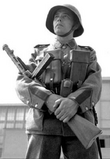MM-26
| This article is a stub. You can help IxWiki by expanding it. |
| Mitraillette Meissler modele 26 | |
|---|---|
 MM-26 | |
| Type | Submachine gun |
| Place of origin | |
| Service history | |
| In service | 1926–1980s (YDF) |
| Used by | See Users |
| Wars | |
| Production history | |
| Designer | Adolf Meissler |
| Designed | 1920s |
| Manufacturer | MAG FNC FS |
| Produced | 1926–46 |
| Specifications | |
| Mass | 4.6 kg (10.14 lb) |
| Length |
|
| Barrel length | 314 mm (12.4 in) |
| Cartridge | 9×19mm Parabellum |
| Action | Straight Blowback |
| Rate of fire | 800 rounds/min |
| Muzzle velocity | 396 m/s (1,299 ft/s) |
| Effective firing range | 200 m |
| Feed system | 71-round drum 20-, 40- or 50-round box magazine |
| Sights | Front blade, rear notch |
The Mitraillette Meissler modele 26, Burgoignesc for "Meissler Submachine Gun model of 1926", abbreviated as MM-26, is a Yonderian submachine gun developed during the interwar years which saw extensive use during the Second Great War. Based on earlier prototypes by Adolf Meissler, the MM-26 entered service with the Yonderian Defence Force in 1926 where it soon earned the affectionate nickname "Mimi". The MM-26 saw widespread use with the Army of Burgundie during the Second Great War, seeing service on all fronts. Replaced in the frontline role by the FAMAG during the 1960s, the MM-26 nevertheless remained in service with the Yonderian Defence Force into the 1980s as a "bunker gun", a close defence port weapon.
Famed for its reliability and flat recoil, the MM-26 is regarded by many as one of the best submachine guns of the Second Great War. Drawbacks to the MM-26 are its weight (4.6 kilograms (10 lb)) and high production cost, requiring skilled machinists to mill the receivers. The MM-26 was highly influential on the design of the Urcean SMP-3.
Design
Development


The MM-26 was designed by Yonderian gunsmith Adolf Meissler in the early 1920s. The weapon came about as a hobby project for Meissler who tinkered with it in his spare time. Initially chambered for 7.5x24mm caliber, Meissler submitted his prototype to the Yonderian Defence Force in 1924 where it was tested by Department 2 (small arms) of the Army Procurement Command. Army Procurement Command ultimately rejected the weapon over a number of concerns centred mostly around the magazine which had occasional feeding issues and the high rate of fire which made the weapon difficult to control when firing fully-automatic.
In November 1925 Meissler once again submitted his design to the Yonderian Defence Force after further tinkering. With a reduced fire rate of 800 rounds per minute and chambered for the more modern 9x19mm cartridge and feeding from 20- or 40-round stick magazines, the Army Procurement Command approved it for service in early 1926. Meissler designed and submitted a 50-round quad-stacked single-feed coffin-shaped magazine and a 71-round drum magazine for the weapon both of which entered service in the late 1920s. The "coffin" magazine carried more ammunition than the box magazine and was lighter than the previous 40-round magazine, however, it was complicated and prone to jamming or failure if it was damaged, reassembled incorrectly, or the springs gave out. It would also fail to fire or feed unless it was properly seated in the magazine well. The "coffin" magazines were withdrawn from service with the YDF in 1937 in favour of the 71-round drums.
Production of the MM-26 was initially limited to the Fabrique Nationale Collinebourg but also came to encompass Manufacture d'Armes de Gabion and Fabrique de Sainte-Catherine to meet production requirements to fulfil contracts. Soon after adoption, the MM-26 was also adapted to function as a "bunker gun". The modification meant doing away with the buttstock, replacing it with a wooden pistol grip. A mount was designed for the MM-26 to slot into such that it could be fitted to bunker doors or firing slits and used as a close defence weapon.
Design features

The MM-26 is a straight blowback submachine gun with a milled receiver and wooden buttstock. A three position safety switch sits immediately outside the trigger guard that switches the gun from safe to semi-automatic to fully-automatic fire. The rate of fire sits around 800 rounds per minute (down from c. 1050 in prototypes). Recoil is kept low in part by a muzzle brake at the end of the barrel and in part by the high mass (4.6 kilograms (10 lb)) of the weapon itself, which gives the MM-26 a high level of controllability even when firing in fully-automatic mode. The weapon feeded from box- or drum magazines, both of which were at various times issued with the MM-26.
Users
Former users
 Burgundie
Burgundie
Papal State - used by the Yonderian Guard
 Yonderre
Yonderre
 Yonderian Defence Force - used from 1926-1980s
Yonderian Defence Force - used from 1926-1980s Custodes Yonderre - used from late 1920s-1980s
Custodes Yonderre - used from late 1920s-1980s
Gallery
- MM-26
-
Volonderre at the front with MM-26, 1940
-
MM-26 "bunker gun" for emplaced use
-
71-round drum magazine, sectioned example on left
-
Yonderian soldier with MM-26, 1930s
-
Custodian of the Custodes Yonderre with MM-26, 1940s




